Daily Current Affairs (CA) for UPSC 15th Oct 2025



| Index |
| S.No | Topic | Page No |
| Daily Hindu Analysis (YouTube) |
| 1. | Powering up the Australia–India clean energy partnership |
|
| 2. | How innovation drives economic growth |
|
| 3. | India to train border security force of Mongolia, says Modi |
|
| 4. | Defence Minister calls for reformed multilateralism upholding global order |
|
| 5. | How does Gaganyaan’s vital crew escape system work? |
|
| 6. | Appoint nodal officers to trace missing children: SC |
|
| Daily Current Affairs |
| 7. | Toyoake’s Screen Time Ordinance |
|
| 8. | Fare Se Fursat Fixed Airfare Scheme |
|
| 9. | The International Committee of the Red Cross (ICRC) |
|
| 10. | LEAPS 2025 |
|
| 11. | Armenia |
|
Powering up the Australia–India clean energy partnership
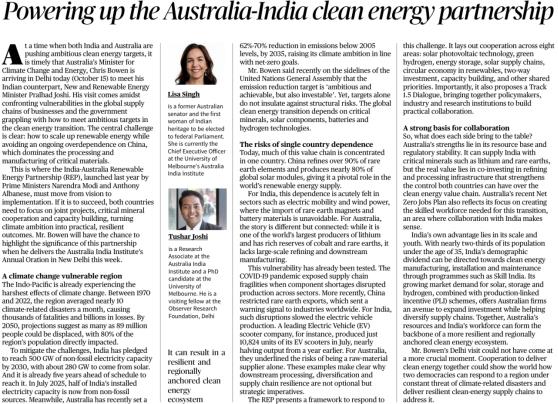
Syllabus Mapping:
- GS Paper II: International Relations – Bilateral and Multilateral Agreements involving India
- GS Paper III: Environment – Energy, Climate Change, and Sustainable Development
Context At a time when both India and Australia are advancing their clean energy transition, Australian Minister for Climate Change and Energy Chris Bowen’s visit to India marks a major step forward in operationalising the India–Australia Renewable Energy Partnership (REP).
Launched in 2022 by Prime Ministers Narendra Modi and Anthony Albanese, this partnership aims to transform the shared climate ambitions of both nations into practical, resilient, and sustainable outcomes. The visit is particularly significant as both countries are seeking to reduce overdependence on China in global supply chains for renewable energy technologies and critical minerals.
What is the India–Australia Renewable Energy Partnership (REP)? The REP serves as a bilateral framework for clean energy cooperation focusing on:
- Joint research and technology development in solar, wind, hydrogen, and battery storage.
- Capacity building for renewable energy professionals.
- Diversifying supply chains for critical minerals and clean-tech components.
- Private sector collaboration in innovation, finance, and green manufacturing.
It also includes the Track 1.5 Dialogue, which connects policymakers, industry, and academia to strengthen renewable energy ties.
Significance of the Partnership
1. Addressing Climate Vulnerability in the Indo-Pacific o The region is already facing severe climate impacts — rising sea levels, erratic rainfall, and frequent natural disasters. o Between 1970–2022, the Indo-Pacific saw a tenfold increase in climate-related fatalities and losses. o By 2050, about 89 million people could be displaced due to climate change impacts. 2. Energy Transition Goals o India has pledged 500 GW of non-fossil electricity capacity by 2030 and aims to derive 50% of its energy from renewables. o Australia has committed to a 62–70% reduction in emissions below 2005 levels by 2035 and to achieve net-zero emissions by 2050. 3. Reducing Supply Chain Dependence on China o China refines over 90% of rare earth elements and produces 80% of global solar modules, giving it significant leverage in renewable technology supply chains. o The partnership helps India and Australia diversify production and build regional self-reliance.
Key Areas of Collaboration
1. Critical Minerals and Supply Chain Resilience o Australia is rich in lithium, cobalt, and rare earths — key materials for electric vehicles, solar panels, and batteries. o India, with its large manufacturing base, can process and deploy these materials, reducing global dependency on China.
2. Green Hydrogen and Storage Solutions o Both countries are investing heavily in green hydrogen production and battery storage technology, essential for achieving energy security.
3. Renewable Infrastructure and Skill Development o Joint collaboration in building clean energy infrastructure and training skilled workers through programmes like Skill India and Australia’s Net Zero Jobs Plan.
4. Circular Economy and Green Financing o Promotion of recycling, waste-to-energy projects, and financing mechanisms for sustainable investments. Challenges
- Supply chain bottlenecks for critical minerals and solar components.
- Investment risks due to global market volatility in renewable energy.
- Need for technological standardisation in green hydrogen and carbon capture.
- Balancing energy transition with energy security amid rising global demand.
Why This Partnership Matters - Enhances strategic cooperation in the Indo-Pacific region, balancing China’s influence.
- Supports India’s renewable energy targets and Australia’s diversification agenda.
- Promotes innovation and green jobs in both countries.
- Aligns with the Quad’s focus on clean energy and resilient supply chains.
- Positions India and Australia as regional leaders in sustainable energy transition.
UPSC Mains Q.
“The India–Australia Renewable Energy Partnership (REP) can serve as a cornerstone for a resilient Indo-Pacific clean energy ecosystem.” Discuss the strategic and environmental significance of this partnership in achieving sustainable energy security for both nations.
How innovation drives economic growth
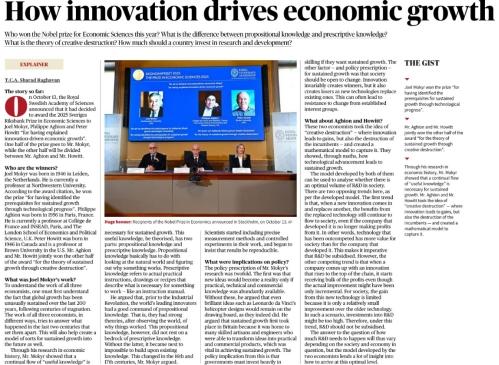
Syllabus Mapping:
- GS Paper III: Indian Economy – Growth, Development, and Employment
- Inclusive and Sustainable Growth
- Effects of Liberalisation on the Economy
- Government budgeting and R&D expenditure
- Science & Technology and Economic Development
Context The 2025 Nobel Prize in Economic Sciences has been awarded to Joel Mokyr, Philippe Aghion, and Peter Howitt for their pioneering research explaining how innovation fuels long-term economic growth.
Their work provides a framework for understanding the interplay between technological progress, creative destruction, and policy support that sustains productivity and prosperity over centuries. This year’s Nobel recognises their contribution to linking innovation, knowledge creation, and entrepreneurship with measurable models of economic growth.
Who are the Laureates?
- Joel Mokyr (Northwestern University, U.S.) – Awarded for explaining how technological knowledge and the “flow of useful ideas” became the foundation for sustained growth since the Industrial Revolution.
- Philippe Aghion (College de France & INSEAD, Paris) and Peter Howitt (Brown University, U.S.) – Jointly honoured for developing the “Theory of Creative Destruction,” a model showing how new innovations replace outdated technologies, leading to productivity growth and long-term prosperity.
Understanding Mokyr’s Contribution Mokyr’s research focuses on why sustained economic growth began in the last 250 years, contrasting it with earlier centuries of stagnation.
He differentiated between two types of knowledge: 1. Propositional Knowledge – Knowing why something works (scientific and theoretical understanding).
2. Prescriptive Knowledge – Knowing how to make something work (practical and engineering knowledge). He argued that combining both forms of knowledge, especially during the Industrial Revolution, allowed societies to continuously innovate — creating a self-sustaining cycle of technological advancement and economic expansion.
Mokyr emphasized the need for “useful knowledge”—the transformation of pure science into practical tools, machinery, and methods that improve productivity.
Aghion and Howitt’s Theory of Creative Destruction
The duo built on Joseph Schumpeter’s concept of creative destruction, formalising it through mathematical models. Their theory explains how:
- Innovation drives economic growth, but also disrupts old industries.
- New technologies increase productivity while rendering old ones obsolete.
- Competition among innovators fuels continuous advancement.
Their model shows that technological advancement and entrepreneurship—supported by appropriate R&D investments and policy environments—lead to long-term sustainable growth.
Policy Implications 1. Investment in R&D – Sustained growth requires continuous public and private investment in research and development, especially where private incentives are weak.
2. Encouraging Experimentation – Governments should promote open, competitive ecosystems that allow new ideas to flourish.
3. Education and Skilling – A skilled workforce capable of adopting and innovating upon new technologies is key to long-run growth.
4. Balancing Subsidies and Incentives – R&D subsidies are justified only when innovations provide large social benefits that exceed private profits.
5. Openness to Change – Policy frameworks must adapt to new technological realities rather than protect outdated industries.
Why This Matters
The laureates’ work helps answer fundamental questions:
- Why did some nations experience sustained growth while others stagnated?
- How do knowledge creation and innovation ecosystems shape productivity?
- What level of government support is optimal for innovation-led growth?
Their insights show that economic progress is not just about capital accumulation but about continuous idea generation and technological renewal.
India’s Context
- India ranks among the top 40 countries in the Global Innovation Index 2024 but still spends only 0.7% of GDP on R&D, far below advanced economies.
- Government initiatives such as Startup India, Atal Innovation Mission, and National Research Foundation (NRF) aim to strengthen innovation ecosystems.
- To sustain long-term growth, India must:
- Increase public–private collaboration in R&D,
- Enhance STEM education and skilling, and
- Focus on technological diffusion across sectors like manufacturing, agriculture, and services.
UPSC Mains Q. “Sustained economic growth depends not merely on capital and labour but on the institutionalisation of innovation.”
Discuss in light of the 2025 Nobel Prize in Economics awarded for explaining innovation-driven growth.
India to train border security force of Mongolia, says Modi
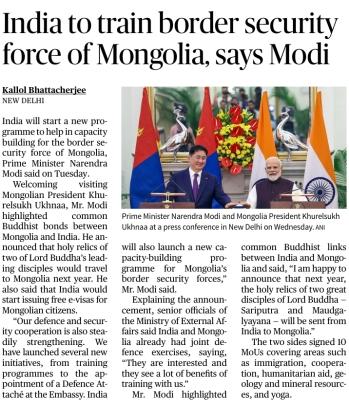
Syllabus Mapping: GSII – International Relations - India and its neighbourhood relations
- Bilateral, regional, and global groupings affecting India’s interests
- India’s foreign policy and soft power diplomacy
- International institutions and agreements involving India
Context India and Mongolia have agreed to strengthen their strategic and defence cooperation through a new capacity-building programme for Mongolia’s border security forces, announced by Prime Minister Narendra Modi during the visit of Mongolian President Khurelsukh Ukhnaa to New Delhi.
The move reflects India’s growing engagement in East and Central Asia under its “Act East” and “Connect Central Asia” policies, alongside deepening Buddhist cultural diplomacy.
What is it All About - India will train Mongolia’s border security personnel as part of a new cooperation initiative.
- Both countries already conduct joint defence exercises, and this programme builds upon existing collaboration.
- India also announced e-visa facilities for Mongolian citizens to enhance people-to-people connectivity.
- Additionally, holy relics of Lord Buddha’s disciples – Sariputta and Moggallana – will be sent to Mongolia in 2026 to celebrate Buddhist heritage.
- The two nations signed 10 MoUs, covering:
- Immigration and consular cooperation
- Humanitarian aid
- Geology and mineral exploration
- Promotion of yoga and traditional medicine
Strategic and Diplomatic Significance 1. Defence and Security Cooperation
Strengthens India’s security footprint in East and Central Asia. o Enhances Mongolia’s capability to safeguard borders amid regional tensions. o Reinforces India’s role as a net security provider in Asia.
2. Cultural Diplomacy Buddhism serves as a strong civilizational link between India and Mongolia. o The transfer of relics underscores India’s use of soft power diplomacy.
3. Geopolitical Context Mongolia’s landlocked location between China and Russia makes India an important third partner for balancing strategic dependence. o India’s engagement complements its strategic outreach in Central Asia, including membership in the Shanghai Cooperation Organisation (SCO).
4. Economic and Energy Ties Cooperation in mineral exploration and clean energy (including uranium and rare earths) aligns with India’s resource diversification goals. o Mongolia’s mineral wealth, especially coal and copper, offers future opportunities for Indian investments. Government Frameworks Supporting This
- Act East Policy – Expanding India’s engagement in East and Southeast Asia.
- Connect Central Asia Policy (2012) – Enhancing India’s strategic, cultural, and economic presence in Central Asia.
- ICCR & ITEC Programmes – Training and capacity-building for partner nations, under which Mongolian officers will be trained.
UPSC Prelims Q. With reference to India–Mongolia relations, consider the following statements: 1. India and Mongolia share a common Buddhist heritage. 2. The two countries are members of the Shanghai Cooperation Organisation (SCO). 3. India is assisting in capacity building of Mongolia’s border security forces. Which of the above statements is/are correct?
(a) 1 and 2 only
(b) 2 and 3 only
(c) 1 and 3 only
(d) 1, 2, and 3
Answer: (c) 1 and 3 only
Defence Minister calls for reformed multilateralism upholding global order Syllabus Mapping - GS Paper II – International Relations
- Important International Institutions, Agencies, and Fora — their structure and mandate
- India’s role in UN and multilateral diplomacy
- Global order and reform of institutions of global governance
Context At the inaugural session of the United Nations Troop Contributing Countries (UNTCC) Chiefs’ Conclave, held for the first time in India, Defence Minister Rajnath Singh emphasized the urgent need to reform outdated multilateral structures to address evolving global security challenges. He reiterated India’s firm commitment to the international rules-based order, while calling for a reformed and inclusive multilateralism that reflects 21st-century realities and ensures a fair voice for developing nations in global governance.
Background
- The UNTCC Chiefs’ Conclave serves as a global platform where senior military leaders discuss challenges in UN peacekeeping operations and explore ways to enhance cooperation.
- The event in New Delhi (October 14–16, 2025) marks a milestone, showcasing India’s leadership as one of the largest troop-contributing nations to the UN.
- India has contributed over 2,90,000 peacekeepers to more than 50 UN missions across the world — from Congo and Korea to South Sudan and Lebanon.
Key Highlights of Defence Minister’s Address 1. Reformed Multilateralism
- Mr. Singh underlined that some nations are violating global norms while others attempt to impose their own rules, thereby weakening international institutions.
- He urged the reform of global governance systems like the United Nations, to make them more democratic, inclusive, and representative of the Global South.
- India’s approach to multilateralism, he said, is rooted in cooperation, not domination, and aims to strengthen the rules-based global order.
2. “4C Formula” for Peacekeeping The Minister proposed a 4C framework as a guiding principle for UN peacekeeping:
- Consultation – Regular engagement among troop-contributing countries.
- Cooperation – Strengthening coordination across nations for effective missions.
- Coordination – Enhancing synergy among UN bodies, host nations, and forces.
- Capacity-Building – Investing in training, logistics, and modern equipment to ensure efficient mission delivery.
3. Use of Technology and Innovation - Mr. Singh advocated the use of secure communications, surveillance systems, and unmanned platforms (like drones) to make UN missions safer and more effective.
- He emphasized that adaptability and innovation, not just bravery, are vital for future peacekeeping.
4. India’s Contribution and Vision - India reaffirmed its unwavering support for UN peacekeeping efforts.
- Mr. Singh highlighted that India is ready to contribute not only troops but also expertise, logistics, and reforms that make peacekeeping accountable, effective, and transparent.
- He also urged technologically advanced nations to share logistics and funding to ensure equitable burden-sharing.
India’s Role in UN Peacekeeping - India has been a pioneer in peacekeeping since its first mission in 1950 (Korea).
- Indian women peacekeepers have also set benchmarks, including the first all-female police unit in Liberia.
- India continues to advocate for greater participation of developing nations in decision-making on UN peacekeeping operations.
- India’s contributions reflect its commitment to global peace, humanitarianism, and international solidarity.
Analysis: Need for Reformed Multilateralism - Current Challenge:
Multilateral institutions like the UN, IMF, and WTO are often seen as outdated, dominated by a few powerful nations, and unable to address contemporary challenges such as terrorism, cyber warfare, and climate-induced conflicts. - India’s Standpoint:
- India champions reformed multilateralism, aiming to democratize global decision-making.
- It seeks greater representation for developing nations, particularly through UN Security Council reform.
- The focus is on ensuring that global institutions remain effective, legitimate, and equitable.
- Strategic Importance:
As a rising global power, India’s call for reform aligns with its vision of becoming a leading voice for the Global South, advocating for a balanced global order based on cooperation, fairness, and respect for sovereignty.
UPSC Prelims Q. With reference to India’s participation in UN peacekeeping operations, consider the following statements: 1. India was the first country to send an all-women peacekeeping contingent to a UN mission. 2. The 4C framework proposed by India at the 2025 UNTCC Conclave stands for Consultation, Cooperation, Coordination, and Capacity-Building. 3. India is the largest troop contributor in the history of UN peacekeeping. Which of the above statements are correct?
(a) 1 and 2 only
(b) 2 and 3 only
(c) 1 and 3 only
(d) 1, 2, and 3
Answer: (d) 1, 2, and 3
How does Gaganyaan’s vital crew escape system work? 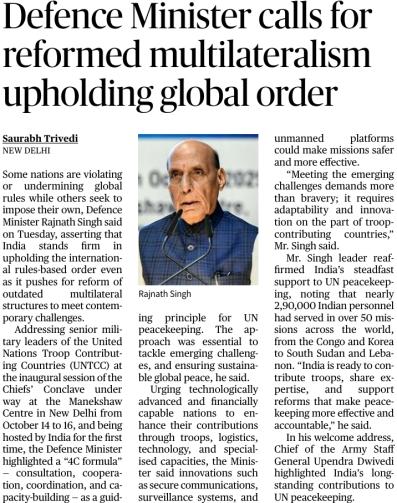
Syllabus Mapping GS Paper III – Science and Technology
- Awareness in the fields of Space Technology
- Achievements of Indians in Science & Technology
- Indigenization of Technology and Development of New Technology
- Security Implications of Space Missions
Context India’s Gaganyaan Mission—its first-ever human spaceflight programme—aims to safely transport Indian astronauts (Vyomnauts) to a low Earth orbit (LEO) of around 400 km altitude using the human-rated LVM3 (HLVM3) rocket, and to bring them back safely to Earth. A key component ensuring astronaut safety is the Crew Escape System (CES), designed to save the crew during any emergency at launch or in the early atmospheric phase of flight. The Indian Space Research Organisation (ISRO) has successfully tested this critical system, demonstrating India’s preparedness for the upcoming manned mission.
Mission Objective The Gaganyaan Programme seeks to:
- Demonstrate human spaceflight capability.
- Test critical technologies such as crew module re-entry, parachute-based recovery, and crew safety systems.
- Pave the way for India’s participation in future international space missions and potential space station operations.
What is the Crew Escape System (CES)? The Crew Escape System is a dedicated safety mechanism designed to rapidly separate the crew module (carrying astronauts) from the rocket in the event of a mission-critical failure—for example, during booster malfunction or explosion. It is engineered to:
- Detect emergencies automatically through onboard sensors.
- Detach the crew module within milliseconds.
- Move it to a safe distance before parachute deployment.
- Ensure crew survival even under extreme G-forces and aerodynamic loads.
The CES is activated during the initial phase of launch—when the rocket is below ~50 km altitude and atmospheric loads are highest.
How It Works
1. Detection of Anomaly:
A network of sensors continuously monitors the health of the rocket’s systems. 2. Activation:
Upon detection of an anomaly, the CES ignites solid-fuel escape motors mounted above the crew module. 3. Separation:
The CES pulls the crew module away from the launch vehicle, reaching safe distance within seconds. 4. Descent:
The module deploys a multi-stage parachute system, reducing descent speed in stages. 5. Splashdown:
The module safely lands in the sea, from where recovery teams retrieve the astronauts.
Why It’s Crucial for Human Spaceflight
- Human safety precedes mission success.
In crewed missions, even a minor launch anomaly can be fatal; CES is designed to prevent loss of life. - The atmospheric phase of flight is especially risky due to high speeds (5× speed of sound) and immense aerodynamic pressures.
- Once solid boosters ignite, they cannot be shut down; hence, CES ensures emergency ejection is still possible.
Types of Crew Escape Systems The CES can be classified into two types based on the ejection mechanism: 1. Puller-Type System (Used in Gaganyaan): o The escape tower sits on top of the crew module. o It uses powerful solid-fuel motors to pull the capsule away from the rocket. o Example: Gaganyaan, NASA’s Apollo missions.
2. Pusher-Type System: o Escape engines are placed at the base of the capsule, pushing it away from the launch vehicle. o Example: SpaceX’s Crew Dragon (Falcon 9). Both have trade-offs — the puller system is simpler but heavier; the pusher type is more reusable and compact. Testing and Validation
- ISRO developed a single-stage Test Vehicle powered by the Vikas engine to validate the CES.
- In October 2023, a successful test was conducted in which the Test Vehicle reached transonic conditions (transition from subsonic to supersonic speeds).
- The CES was automatically activated, and the crew module splashdown was successfully achieved in the Bay of Bengal.
- Further Test Vehicle missions (TV-D1, D2, D3) are planned to simulate various emergency conditions before the final manned Gaganyaan launch.
Key Technological Features - Integrated Vehicle Health Management System (IVHMS):
A network of sensors, electronics, and software that monitors rocket systems and crew health in real-time. - Redundant Design:
Multiple backup systems ensure reliability even under critical failure. - Human-Rated Certification:
The HLVM3 rocket is specially modified to meet human safety standards.
Global Comparison | Country | Programme | Escape System Type | Notable Test |
| USA | Apollo / Artemis | Puller | Apollo Pad Abort Test (1965) |
| Russia | Soyuz | Puller | Soyuz MS-10 (2018) — saved crew mid-flight |
| USA | SpaceX Crew Dragon | Pusher | In-flight abort test (2020) |
| India | Gaganyaan | Puller | TV-D1 (2023) successful |
Significance for India - Marks India’s entry into the elite human spaceflight club (after USA, Russia, and China).
- Strengthens ISRO’s ability to conduct future deep-space missions (Moon, Mars).
- Demonstrates indigenous capability in human-rated launch vehicle design.
- Boosts national pride and scientific capacity under Atmanirbhar Bharat.
Government Initiatives - Gaganyaan Programme (₹9,023 crore): Launched by ISRO under the Department of Space, Government of India.
- Vyommitra Humanoid: A pre-human flight test robot developed to simulate astronaut conditions.
- Collaboration with DRDO: For life-support systems and crew safety materials.
- Partnerships with Indian Navy: For sea recovery operations.
UPSC Prelims Q. With reference to the Gaganyaan Mission, consider the following statements: 1. The Crew Escape System (CES) is designed to detach the crew module only during the orbital phase of the mission. 2. ISRO uses a puller-type CES mechanism similar to that used in NASA’s Apollo missions. 3. The CES Test Vehicle developed by ISRO is powered by the Vikas engine. Which of the above statements are correct?
(a) 1 and 2 only
(b) 2 and 3 only
(c) 1 and 3 only
(d) 1, 2, and 3
Answer: (b) 2 and 3 only
Appoint nodal officers to trace missing children: SC Context The Supreme Court of India has directed the Union Government to instruct all States and Union Territories to appoint nodal officers responsible for tracing missing children.
The order was issued in response to a public interest litigation (PIL) filed by Guria Swayam Sevi Sansthan, a non-profit organization, highlighting the growing number of untraced missing children across the country despite existing digital tracking systems.
What is the Issue All About
- Despite the presence of a dedicated Mission Vatsalya portal operated by the Ministry of Women and Child Development (MoWCD), the Court noted that there is poor coordination and information sharing between the Centre, States, and law enforcement agencies.
- The Court emphasized that the appointment of State-level nodal officers and their contact details must be uploaded on the Mission Vatsalya portal.
- These officers must ensure prompt response and coordination whenever a complaint of a missing child is received.
Supreme Court’s Directions 1. Appointment of Nodal Officers: Every State and UT must appoint a nodal officer for handling missing children cases. o Details of these officers should be uploaded on the Mission Vatsalya portal.
2. Data Sharing and Coordination: Any complaint about a missing child must be immediately shared with the respective nodal officer. o Officers must take swift action to trace the child, identify perpetrators, and register necessary cases.
3. Integration with Existing Platforms: The Court was informed that earlier platforms — TrackChild and Khoya-Paya — have been merged into Mission Vatsalya to create a unified tracking system.
4. Better Coordination Between Centre and States: o Justice B.V. Nagarathna emphasized that the system can be effective only through joint cooperation between the State and the Centre.
About Mission Vatsalya
- Launched by: Ministry of Women and Child Development (MoWCD).
- Objective: Ensure protection, welfare, and rehabilitation of children in need of care.
- Components: Child protection services, institutional and non-institutional care, and support to State Child Protection Societies.
- Digital Platform: Integrates databases on child adoption, trafficking, and missing children.
Significance of the Judgment - Strengthens accountability and responsiveness in child protection systems.
- Encourages digital governance for faster coordination among agencies.
- Reinforces the constitutional mandate under Article 21 (Right to Life) and Article 24 (Protection of Children).
- Helps address the rising trend of child trafficking and abductions linked to missing children cases.
Government Initiatives Related to Child Protection 1. Mission Vatsalya (2021): Strengthening child protection and care systems.
2. TrackChild Portal: Online tracking and monitoring of missing and found children.
3. Khoya-Paya Portal: Citizen platform for reporting and searching missing children.
4. Childline 1098: 24-hour helpline for children in distress. 5. POSCO Act, 2012: Protection of children from sexual offences.
UPSC Prelims Q. Which of the following statements is/are correct regarding the Mission Vatsalya scheme?
1. It is implemented by the Ministry of Home Affairs.
2. It aims to ensure the protection, welfare, and rehabilitation of children in need of care.
3. The TrackChild and Khoya-Paya platforms are integrated into the Mission Vatsalya portal.
(a) 1 and 2 only
(b) 2 and 3 only
(c) 1 and 3 only
(d) 3 only
Answer: (b) 2 and 3 only
Toyoake’s Screen Time Ordinance
Syllabus: GS Paper II – Governance (Government Policies and Interventions) Context:
The Japanese city of Toyoake, near Nagoya, has enacted a local ordinance recommending that residents limit their screen time to two hours a day, aiming to address issues of digital addiction and social isolation.
Key Points:
- Introduced in: October 2025 as a municipal guideline.
- Objective: To enhance mental well-being and promote real-world social interaction by curbing excessive smartphone dependence.
- Scope: Applies to all residents, including adults and children, but excludes work and study hours.
- Nature: Voluntary and non-punitive — there are no fines or penalties for non-compliance.
- Approval: Passed by the city council (12–7 vote) following public consultations.
- Approach: Encourages self-regulation, awareness of digital addiction, and revival of face-to-face communication.
- Significance: Toyoake becomes one of the first cities globally to officially promote reduced screen time through local governance.
Source: The Hindu
Fare Se Fursat Fixed Airfare Scheme
Syllabus: GS Paper III – Infrastructure (Civil Aviation Sector) Context:
The Union Civil Aviation Minister launched Alliance Air’s “Fare Se Fursat” Fixed Airfare Scheme, aimed at ensuring affordable and predictable air travel by eliminating fare fluctuations, in line with the UDAN vision.
Key Points:
- Implemented by: Alliance Air, a government-owned regional carrier.
- Objective: To democratize air travel by making it affordable, transparent, and stress-free for middle-class and first-time flyers.
- Unique Feature: Introduces a single fixed airfare for each route—unchanged even for last-minute bookings.
- Pilot Phase: Operational from October 13 to December 31, 2025, across select UDAN routes.
- Passenger Benefit: Removes the uncertainty of dynamic ticket pricing, ensuring predictability and affordability.
- Focus on Inclusion: Encourages passengers from Tier-2 and Tier-3 cities to opt for air travel.
- Alignment: Supports the UDAN initiative and promotes the vision of “Naye Bharat ki Udaan”, positioning aviation as a public service rather than profit-driven.
About Alliance Air: - Nature: Government-owned regional airline under Air India Asset Holdings Limited (AIAHL).
- Role: Backbone of India’s Regional Connectivity Scheme (UDAN).
- Established: April 1996, originally as a subsidiary of Indian Airlines, and continued as a state-owned carrier after Air India’s privatization in 2021.
Source: LM
The International Committee of the Red Cross (ICRC) 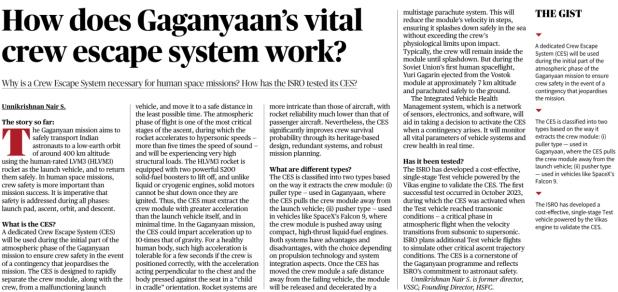
Syllabus: GS Paper II – International Relations (Global Humanitarian Organisations) Context:
The International Committee of the Red Cross (ICRC) has been playing a crucial humanitarian role in facilitating hostage and prisoner exchanges between Israel and Hamas (2023–2025), reaffirming its position as a neutral intermediary in global conflicts.
Key Points:
- Established In: 1863 by Henry Dunant, a Swiss humanitarian, after witnessing the Battle of Solferino (1859).
- Headquarters: Geneva, Switzerland.
- Nature: A neutral, impartial, and independent humanitarian organization working to protect human life and dignity during wars and disasters.
- Aim: To ensure adherence to International Humanitarian Law (IHL) and provide humanitarian assistance to conflict-affected populations.
- Global Reach: Represents a network of over 80 million members and volunteers under the Red Cross and Red Crescent Movement.
- Emblems: Uses the Red Cross, Red Crescent, and Red Crystal (added in 2005) as symbols of protection and neutrality.
- Key Functions:
- Humanitarian Protection: Safeguards civilians, detainees, and refugees in conflict zones.
- Relief and Medical Aid: Provides healthcare, shelter, and emergency support during war and disasters.
- Restoring Family Links: Reunites families separated by conflict through tracing services.
- Promotion of IHL: Ensures respect for the Geneva Conventions and humane treatment of victims.
- Neutral Mediation: Serves as a trusted intermediary in hostage exchanges and ceasefire arrangements, as seen in Gaza (2025).
Source: DH
Syllabus: GS Paper III – Infrastructure (Logistics Sector) Context:
The Union Minister for Commerce and Industry launched the Logistics Excellence, Advancement, and Performance Shield (LEAPS) 2025 in New Delhi to recognize and promote excellence and innovation in India’s logistics ecosystem.
Key Points:
- Implemented by: Department for Promotion of Industry and Internal Trade (DPIIT), Ministry of Commerce and Industry.
- Objective: To benchmark logistics excellence and strengthen India’s global competitiveness in line with the National Logistics Policy (NLP) and PM GatiShakti.
- Focus Areas: Promotes best practices, innovation, and leadership across India’s logistics and supply chain sectors.
- Coverage: Includes diverse players — air, road, sea, and rail freight operators, warehousing, multimodal transporters, MSMEs, Startups, and Academia.
- Sustainability Component: Emphasizes ESG (Environmental, Social, and Governance) standards and Green Logistics initiatives.
- Collaboration Aim: Encourages stronger partnerships between Government, Industry, and Academia to enhance efficiency, transparency, and resilience in logistics operations.
Source: PIB
Armenia
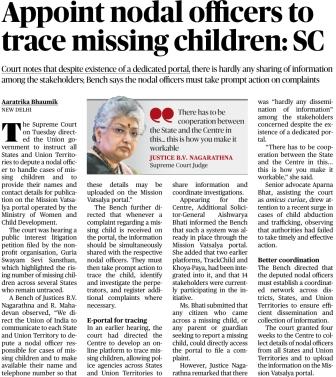
Syllabus: GS Paper I – Geography (World Geography) Context:
Armenia has recently become the newest State Member of the International Union for Conservation of Nature (IUCN), strengthening its commitment towards global environmental conservation and sustainable resource use.
Key Points:
- Location: Landlocked nation in the South Caucasus region.
- Borders: Georgia (north), Azerbaijan (east), Iran (southeast), and Turkey (west).
- Terrain: Dominated by the Lesser Caucasus Mountains with rugged highlands and volcanic soil.
- Highest Peak: Mount Aragats (4,090 m) – an extinct volcanic peak.
- Major Rivers: Aras, Hrazdan, Arpa, and Vorotan, crucial for hydropower and irrigation.
- Natural Resources: Includes gold, copper, molybdenum, zinc, and bauxite.
- Major Lake: Lake Sevan – the largest lake in Armenia.
- Language: Armenian is the official and national language.
- Capital: Yerevan
About International Union for Conservation of Nature (IUCN): - Founded: 1948
- Nature: A membership-based global organization comprising governments and civil society organisations (CSOs).
- Objective: Promotes conservation of nature and sustainable use of natural resources.
- Role: Provides tools, knowledge, and global platforms for nature conservation aligned with economic and social development.
- Network: Over 1,300 member organisations, making it the world’s largest and most diverse environmental network.
Source: News On Air








